Proposed sites to host inshore fisheries pilots 2017: consultation
Consultation seeking views on proposals for the Inshore Fisheries Pilot initiative.
Proposal 4 - Outer Hebrides
A brief summary of the proposal. Please see the proposal form for more details ( http://www.gov.scot/Resource/0052/00525817.pdf )
Who has put forward the proposal
Outer Hebrides Regional Inshore Fisheries Group.
The area to which the proposal would apply
The proposed area includes the waters stretching from Stornoway shore at latitude 58 11.00N south to Barra at latitude 56° 43.870N.
The Eastern boundary is the line, in the middle of the Minches, which separates the Outer Hebrides RIFG from the West Coast RIFG.
Figure 21: Map of proposed Outer Hebrides Creel Limitation Area.
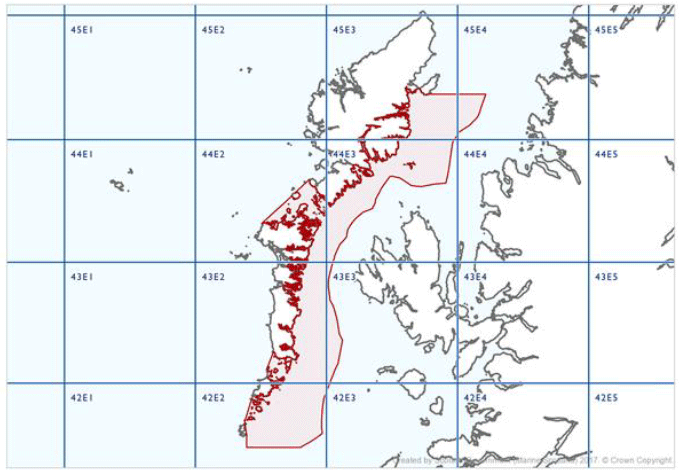
What changes would be brought into effect
A proposal to limit the number of creels that vessels may operate in the area identified above.
The management measures we seek views on are:
- All creels/pots set in the specified area must have an identification tag which will be unique to each vessel.
- All marker buoys set must have the vessel’s name and registration number on each marker buoy.
- No vessel may haul another vessel’s creels without firstly obtaining clearance from Marine Scotland Compliance.
- Creel limits to be set as per vessel size banding specified in the approved Fisheries Management Plan for the Outer Hebrides RIFG area. This is as follows:
| Vessel Size | Maximum Number of creels permitted |
|---|---|
| Under 8 metres | 800 |
| Between 8 and 10 metres | 1,200 |
| Between 10 and 12 metres | 1,500 |
| Over 12 metres in length | 1,800 |
Changes from original proposal:
| Management Measure Proposed | Reason for Removal |
|---|---|
| Additional restriction on number of creels operated by unlicensed fishermen | Currently unable to limit the number of creels operated by unlicensed fishermen. |
| Restrictions on number of shellfish that unlicensed fishermen can retain on board and in storage. | New provisions covering catch restrictions for unlicensed fishermen introduced earlier this year |
| Additional limitation on permitted creel numbers based on crew number | Difficulties in verifying crew numbers. |
The expected benefits
The proposers believe that the number of creels set in the inshore waters of the Outer Hebrides has been increasing year on year for the last 20 years. The proposed creel limitation area is from the east of Lewis south to Barra and is the most heavily fished static gear area in the Outer Hebrides RIFG area.
Specifically, the Outer Hebrides RIFG believe that the proposal would:
- Help reverse decreasing catch per unit effort rates. They believe that catch rates for the creel fisheries in the area have been declining and resulted in fishers setting more creels in order to maintain total catches.
- Help reduce gear conflict, which they believe is increasing. There would be less gear conflict between static gear and mobile gear vessels.
- Prevent gear being placed on the ground to stop others from fishing. It is believed that in some instances several thousand creels are being placed on the ground and hauled irregularly.
- Help improve health and safety. Concerns are expressed about the welfare of crews on creel vessels, especially the prolonged working hours of those on some vessels.
- Encourage the fishing industry to take a more responsible role in the management of the marine environment by taking an active role in the policing of creel restrictions.
How changes will be monitored
The Outer Hebrides RIFG suggests that the current logbook system be amended to ensure that accurate feedback is gained on the catch per unit effort used within the pilot area.
Marine Scotland Estimation of Fishing Activity in the Area
The creel sector is very important to the economy of the Outer Hebrides, providing employment throughout the island chain. In 2016, landings of creel-caught Nephrops, lobsters, brown crabs and velvet crabs into the Outer Hebrides were worth £5.5 million. The analysis below investigates the importance of these creel-caught species.
Value of Creel-caught Nephrops Fishery
Figure 22 shows the tonnage and value of creel-caught Nephrops landed into the Outer Hebrides between 2011-16. As can be seen, there is an increase in landings up until 2013, followed by a decrease from 2014 onward, but with the tonnage and value stabilising between 2015 and 2016.
Figure 22: Tonnage and Value of Nephrops landed by creel into the Outer Hebrides, 2011-16.
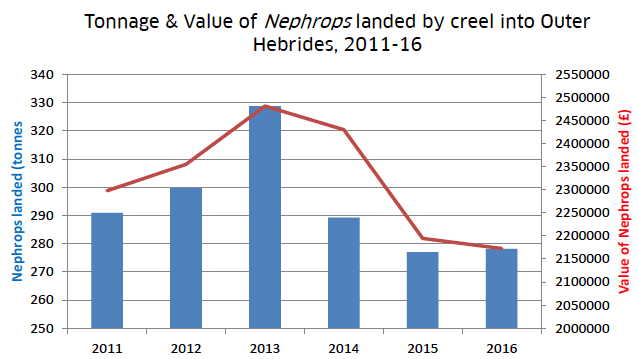
Value of Creel-caught Brown Crab Fishery
The tonnage and value of brown crab landed into the Outer Hebrides is broadly consistent throughout the period but with a marked increase between 2015 and 2016 in terms of tonnage and value.
Figure 23: Tonnage and Value of brown crab landed by creel into the Outer Hebrides, 2011-16.
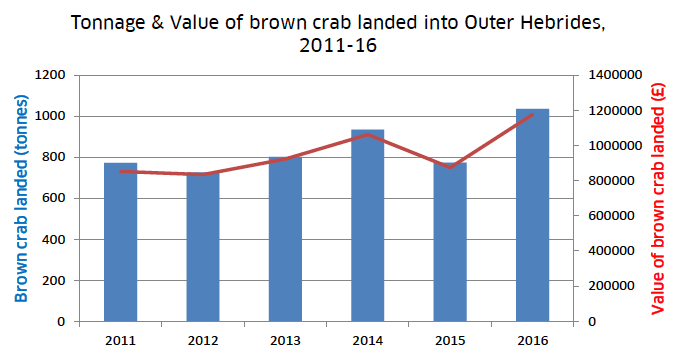
Value of Creel-caught Velvet Crab Fishery
As with the brown crab fishery, the tonnage and value of velvet crab landed into the Outer Hebrides is relatively consistent throughout the period. While there is a small increase in the tonnage landed in 2016 relative to 2015, there is a greater increase in the value of the 2016 landings.
Figure 24: Tonnage and Value of velvet crab landed by creel into the Outer Hebrides, 2011-16.
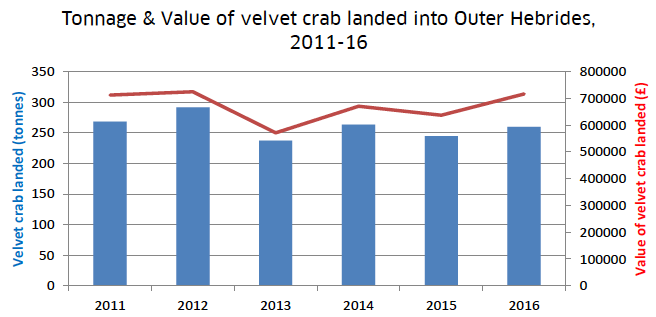
Value of Creel-caught Lobster Fishery
There is a greater fluctuation in the tonnage and value of lobster landed into the Outer Hebrides than for brown crab or velvet crab over the period, as shown in Figure 25.
Figure 25: Tonnage and Value of lobster landed by creel into the Outer Hebrides, 2011-16.
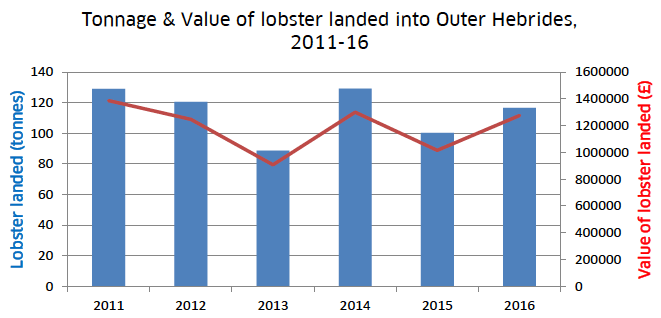
Questions
13. Do you agree that the pilot proposal for the management of creel numbers around the Outer Hebrides should be taken forward by Marine Scotland as described?
14. What is your view on the possible impact, both positive and negative, of limiting permitted creel numbers based on vessel size?
15. What is your view on the possible impact, both positive and negative, of requiring that all marker buoys set must clearly display the vessel’s name and registration number?
16. What is your view on the possible impact, both positive and negative, of requiring that no vessel may haul another vessel’s creels without first obtaining clearance from Marine Scotland Compliance?
Contact
There is a problem
Thanks for your feedback